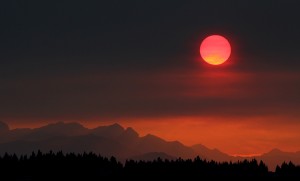Wildfires Scorch Western United States
August 24, 2015

In an August 2015 photo, the sun turns red as it sets through the smoke behind the Olympic Mountains in central Washington. Wildfires in the state left a black, smoky haze hanging over the entire area.
(Credit: © Larry Steagall, Kitsap Sun/AP Photo)
Some 30,000 firefighters, including some who have arrived from Australia, Canada, and New Zealand, are being deployed this week to combat an unprecedented outbreak of wildfires blazing across the United States. In all, 17 states are actively fighting wildfires this August, during one of the driest and most explosive wildfire seasons on record. California, Idaho, Montana, Oregon, and Washington each report that at least 10 large wildfires are currently raging. These wildfires have claimed the lives of 13 firefighters.
A wildfire is the uncontrolled burning of large areas of vegetation. Depending on where they occur, such fires may also be called brushfires, bushfires, or forest fires. Wildfires may be ignited by human activities or by natural causes. Such natural causes include lightning or even intense sunlight. A wildfire can happen in any area with vegetation. Such areas include forests, grasslands, and shrublands. The intensity of a wildfire depends on the type of vegetation fueling it, the terrain, and the weather.
Since January 1, 2015, more than 41,000 individual wildfires in the United States have burned more than 7.2 million acres (2.9 million hectares), mostly in the Pacific Northwest and Alaska. That amount is already almost three times the 2.6 million acres that burned throughout the entire United States in all of 2014. This year’s fires have already burned more land than in any other year over the last decade. This year’s wildfires have been fueled by drought and record high temperatures.
Climate scientists attribute this year’s high temperatures and dry conditions to climate change caused by global warming. Data from the U.S. Forest Service indicates that the fire season, typically occurring over the summer months from June through August, now extends almost year round, averaging 78 days longer compared to fire seasons in the 1970’s. A huge mass of warm water that has settled in the Pacific Ocean off the West Coast of the United States is partially to blame. Climate scientists also point to a warm-water current called El Niño developing in the Pacific. In the United States, El Niño causes the climate to become drier than normal in the Pacific Northwest. Heavier-than-normal winter rains in the region, which often occur with El Niño, provide hope that this wildfire season won’t last.
Other World Book articles


